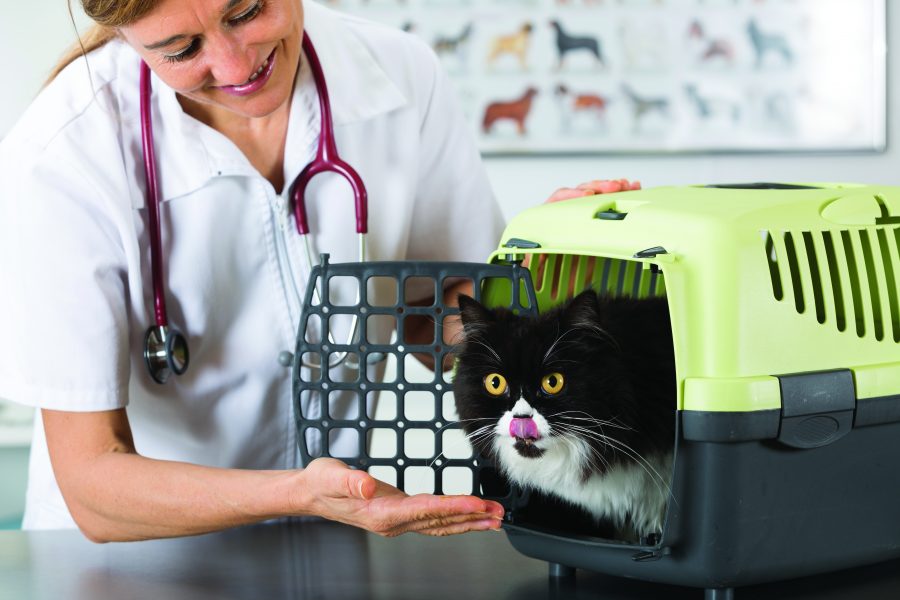If you’re a cat owner, you may or may not have heard of a relatively common condition in older felines known as hyperthyroidism. Hyperthyroidism is an endocrine, or hormonal, disease that affects the thyroid gland. I would wager most of us don’t really spend too much time thinking about our thyroid glands, but for their small size, they play a large role in regulating the body’s functions!
The thyroid glands (there are two) are found in the neck along the right and left side of the trachea (windpipe). Thyroid gland tissue is responsible for the production of thyroid hormones as well as other hormones, and thyroid hormone production depends on iodine. (Interesting factoid: historically, people would develop goiters, or overgrown thyroid glands, because they were iodine deficient.) The concentration of iodine in the thyroid glands is actually 30 times higher than in other parts of the body!
Thyroid hormones are involved with regulating basal metabolic rate, heart contraction and rate, gastrointestinal motility, muscle development, bone metabolism, red blood cell development, and numerous other processes in the body. Pretty much all body systems are affected by thyroid hormones. Because of this, the body normally tightly regulates the amount of thyroid hormone circulating in the blood through varying feedback mechanisms.
Feline hyperthyroidism, therefore, occurs when thyroid hormone becomes unregulated— specifically, there is too much hormone being produced. Most commonly, this is due to a benign tumor or overgrowth of thyroid tissue that then secretes excess hormone. It is not usually cancerous, meaning the tissue does not invade and spread elsewhere in the body, but unfortunately the excess of thyroid hormone can have significant consequences.
Hyperthyroidism is a disease of older, senior cats, and clinical signs can include weight loss in spite of increased appetite, increased water intake and urination, behavior change (often aggression or irritability), and some GI signs (diarrhea and vomiting). There can also be changes to the cat’s hair coat, nails, and musculature. If left untreated, a patient could develop more serious health consequences.
If you notice these signs in your senior feline companion, you will want to have him or her evaluated by your veterinarian. The doctor will then likely recommend at minimum blood and urine tests including thyroid function to see if the cat’s thyroid hormone level is normal and to rule out other diseases that can cause similar signs. If a cat is hyperthyroid, it is also recommended to assess kidney function and blood pressure as these can commonly be affected, especially with more advanced disease. Therefore, the earlier treatment is pursued, the less likely long-lasting damaging effects may occur on the rest of the body.
The gold standard for treatment is radioactive iodine, or radioiodine, therapy. As I mentioned earlier, iodine is used by thyroid gland tissue to produce the hormone for the body and is stored there in a much higher concentration. When hyperthyroid cats receive an injection of radioiodine, the iodine travels preferentially to the overgrown thyroid tissue, thereby selectively targeting and destroying the cells that are causing disease while sparing the rest of the body. This procedure can only be done at specialty centers with facilities that allow for isolation of the cats undergoing radioactive iodine therapy. Technically, the cats are “radioactive” for a period of time, and therefore contact with humans must be minimized to avoid radiation exposure. Although this may sound intimidating, the procedure is quite safe. Once a hyperthyroid cat is treated with radioiodine, he usually does not need further therapy, which is one of the key benefits of this procedure and why it is recommended as the best standard of care.
Of course, radioactive iodine therapy is not attainable for all patients and clients. The next best therapy is medical management with a drug called methimazole (trade name “Tapazole”). Methimazole works by inhibiting an enzyme involved with producing thyroid hormone, thereby helping to lower thyroid hormone levels in the body. The effect is reversible; so, if the drug is stopped, a hyperthyroid cat’s thyroid hormone will return to an elevated level. Therefore, drug therapy must be given indefinitely. Methimazole is given either orally or topically (oral more consistent in absorption) and a patient’s dosage may need adjustment. Therefore, initially frequent monitoring with labwork is needed to ensure normal thyroid levels and to monitor for potential adverse effects. These are rare but can include changes to red and white blood cells and liver injury. More commonly seen adverse effects (but still infrequent) include GI signs, such as decreased appetite and vomiting, or skin scratching, especially around the ears and face.

The last two options for hyperthyroid cats are recommended less frequently, either because of increased risk of complications and high cost (surgery) or low success rate (diet). Surgery, or a thyroidectomy, involves surgical removal of the thyroid glands, which can be challenging due to their location, as well as the numerous risks, including bleeding, anesthesia, nerve damage, etc. Diet involves feeding a prescription diet (for example, Hill’s Y/D), which contains no iodine, but this option often is unsuccessful, because it can be challenging to keep the cat from eating any other foods or treats.
In general, hyperthyroidism is a relatively common disease of SENIOR cats (usually 10+ years). It can cause drastic changes to a cat’s appearance and behavior but is relatively easy to diagnose with appropriate testing, and it is quite treatable. As with any health concern, you should always discuss the best treatments options for your pet with your primary care veterinarian.
VCA Rancho Mirage Animal Hospital is located at 71-075 Highway 111, Rancho Mirage, CA. (760) 346-6103. Visit vcaranchomirage.com
QUICK FACTS
Hyperthyroidism clinical signs can include:
• weight loss in spite of increased appetite,
• increased water intake and urination,
• behavior change (often aggression or irritability),
• GI signs (diarrhea and vomiting),
• changes to the cat’s hair coat, nails, and musculature.



